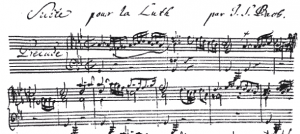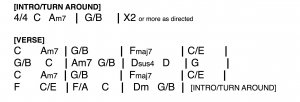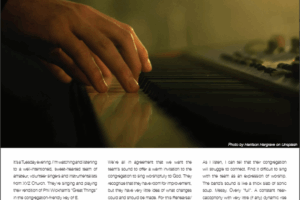Take this link to read the full article about Grant's More Than Music Workshops, as…
M3 VIDEO #8 – INCORPORATING NOTATION-READING MUSICIANS
By Grant Norsworthy
Watch this short video. To understand the thought process behind the teaching video, read the blog post below it.
The video above is #8 in the More Than Music Mentor training resource series.
For hundreds of years, since the birth of classical music, any serious instrumentalist or vocalist (at least, from the European tradition) would have to be able to read pages of a particular form of music notation that instructed them on exactly what to play and how to play it. Sometimes called “staff notation”, this written form of musical language uses lines, dots, symbols, letters, words, and more to tell the musician practically every detail of the music that they had to reproduce.
Check out this little bit of hand-written musical notation by J. S. Bach (1685–1750)!

I have some experience and ability to read musical notation from my early years learning piano, playing brass instruments and from studying music in high school and as part of my college degree. But I was never very good at it. Reading musical notation was always difficult for me. While there was a joy in music at that time, the joy was somewhat offset by the onerous chore of reading notation.
But then I discovered playing without notation. Playing by ear. A new musical world of creativity, self expression and joy exploded for me. Music like this was wonderful! Approaching music – without the specific confinement of staff notation – certainly fit me better.
Since picking up the bass guitar and beginning to play music in rock bands (including quite a few years as a recording, touring pro), the number of times I have been asked to read notation – within my role as a bassist – could probably be numbered on one hand! That’s very few times. Ironically, any notation reading skill I had has become extremely rusty over my pro-musician years through under use!
I’d play by listening to the other instruments and creating my own bass parts – exploring different possibilities, considering the many options and arriving at what I thought worked best. All the musicians in the band would interact, throw out suggestions and together, we’d craft a piece of music that we liked most. This was especially the case when writing and arranging original music. The lines between writing, arranging and producing were wonderfully blurred.
If I was being asked to reproduce an existing song arrangement, I would listen to a sound recording and memorize the most important details and “feel” of the previously recorded bass part, but still leave some room for my own interpretation. Quite often a much simpler form of musical notation – the chord chart – would be used to aid memorization of the sound recording.
At times, just a chord chart (without the support of a sound recording) would be presented to me. These very loose guidelines would demand that each instrumentalist bring a great deal of themselves – musically – to the performance and hammered home the necessity of listening carefully to the other instruments.
Here’s an example of one of the many ways a chord chart might look.

I wish I was better schooled to read and understand written music – staff musical notation and music theory. These are important skills and, in many musical situation – extremely important, beneficial and even necessary.
From one way of thinking about it, there are two “schools” of playing music: one that depends on written, musical staff notation and another that does not. Each “school” or system of playing music has strengths and weaknesses. The details of these might make the subject of a future blogpost, but don’t need to be discussed here.
The reason I explain all this is to make this point: These two approaches do not represent a “correct” way and an “incorrect” way. Neither is inherently better than the other in every musical situation. They are just different. And they can be complimentary.
But the people belonging to each “school” can easily think of their way as being the preferred way. The favored way. Cliques can form. Even within the Church, the team of established musicians – influenced heavily by the leadership – can rely mainly on one system or the other and, perhaps even without intentionally doing so, may exclude anyone from the other “school”.
Wouldn’t it be wonderful if the musicians who prepare sacred music in the life of the Church were intentional about recognizing and utilizing capable musicians of all “schools”? We ought to lean towards each other to learn from one another, understand each other better, pick up some of the language of the other “school” and, in so doing, become more effective at creating a unified musical “voice” that would better serve The Church.
J.S.Bach could hear his music in his head and play it by ear first. He only wrote it as notation so what he heard could be understood and reproduced by other instrumentalists. Thank God he did! There are musicians who are equally comfortable in the formal, notated “school” and the play-by-ear “school” of music. Of course, that’s the ideal. That’s the best set of skills for a musician to have, but it is quite rare.
There may be very capable instrumentalists within your Church congregation who don’t get involved in the music because they have a more formal musical background and only feel comfortable playing when they are reading staff notation. In this instructional video, I speak about how we can and should incorporate these musicians, even if they are unfamiliar with learning to play a song from a chord chart and a sound recording.
Watch Video#8 – Incorporating Notation-Reading Musicians again.
Take this link to watch the full rendition of “Be Thou My Vision” featuring classical musician Syneva Colle on cello.
For more free resource videos and info, visit www.MoreThanMusicMentor.com.


